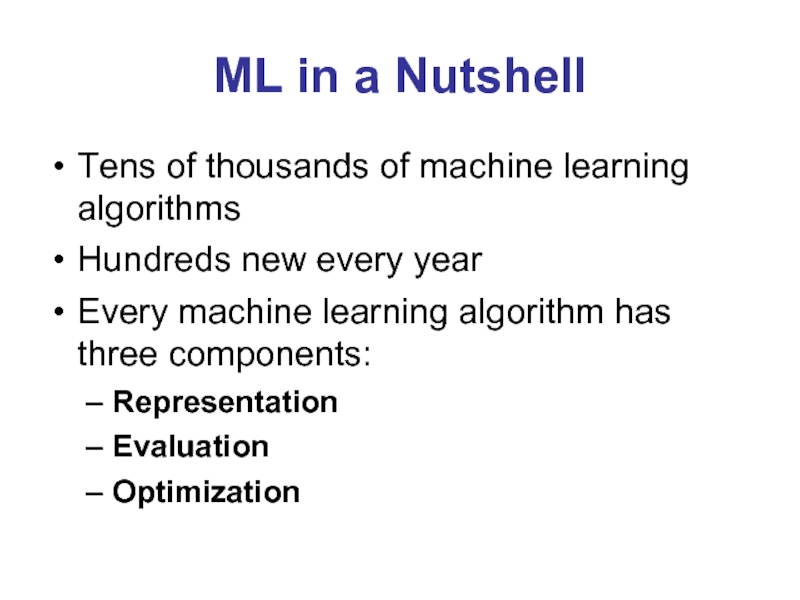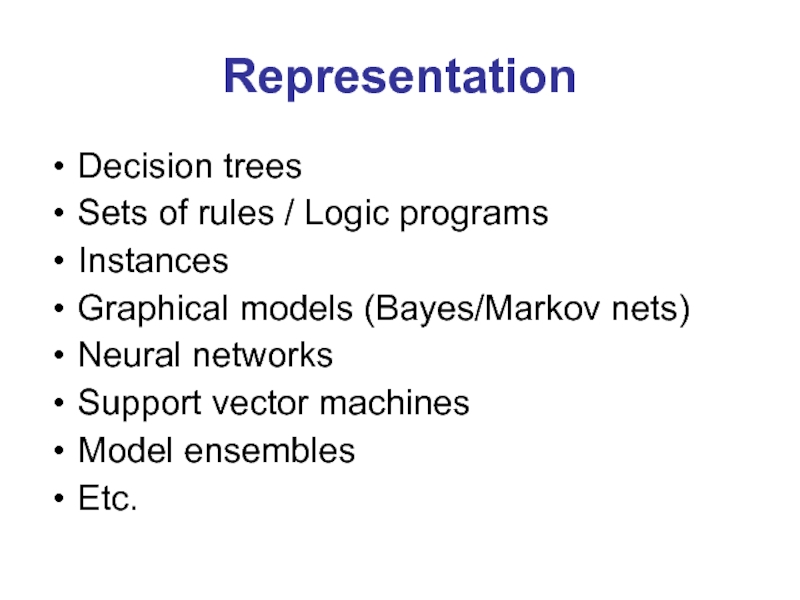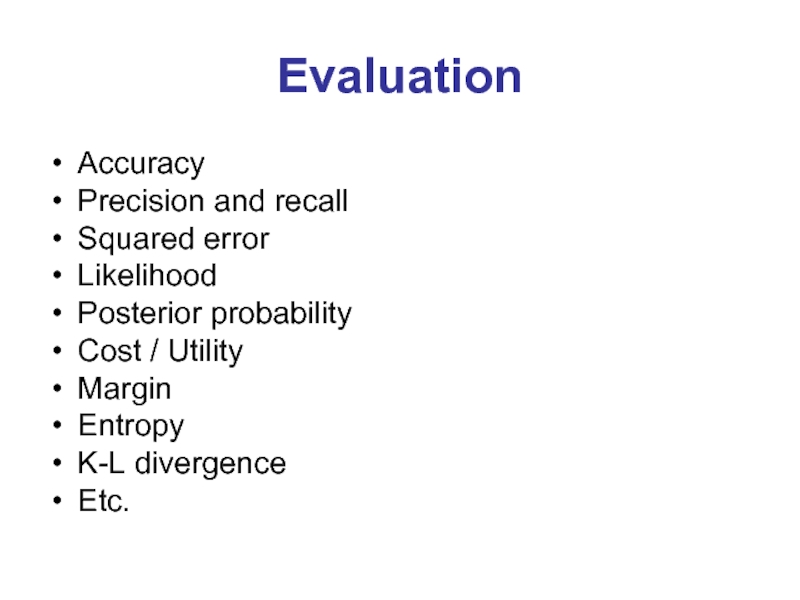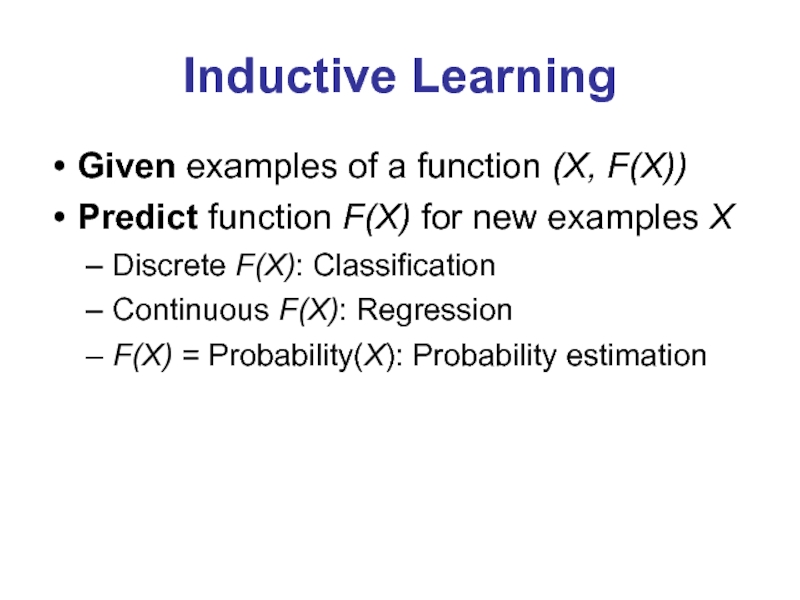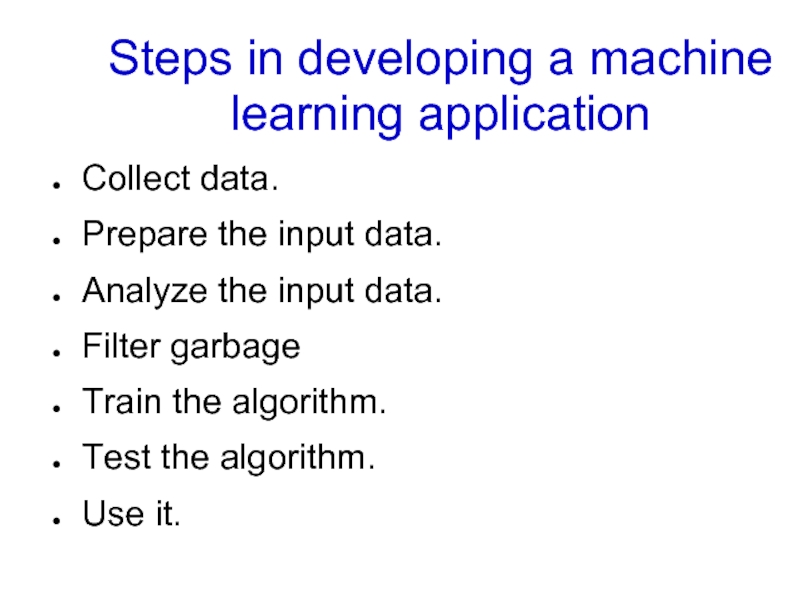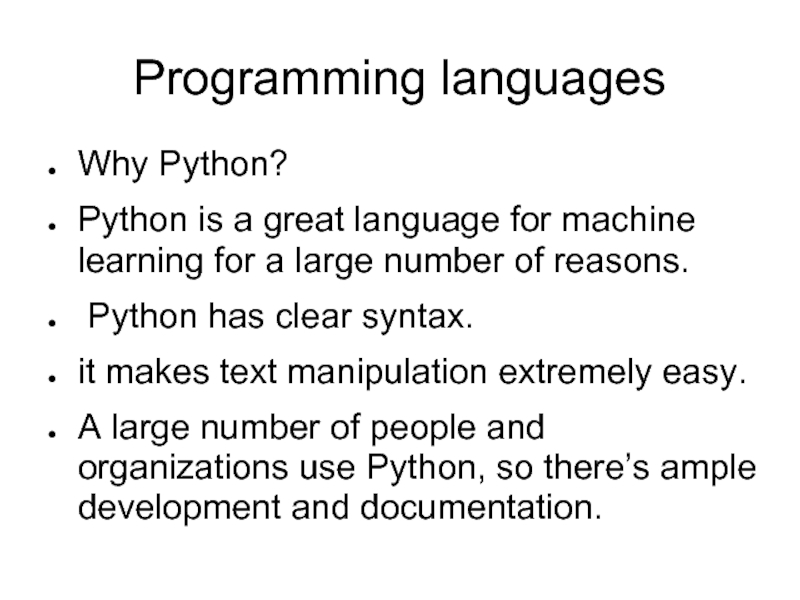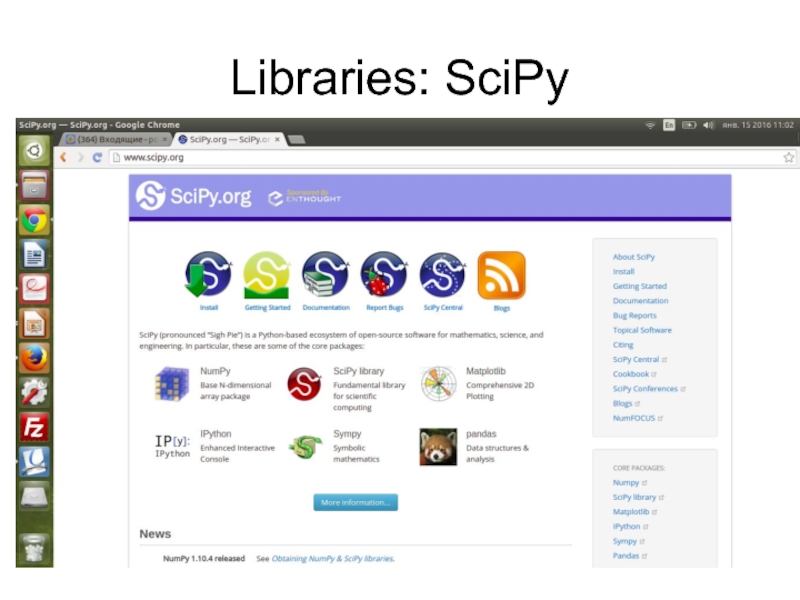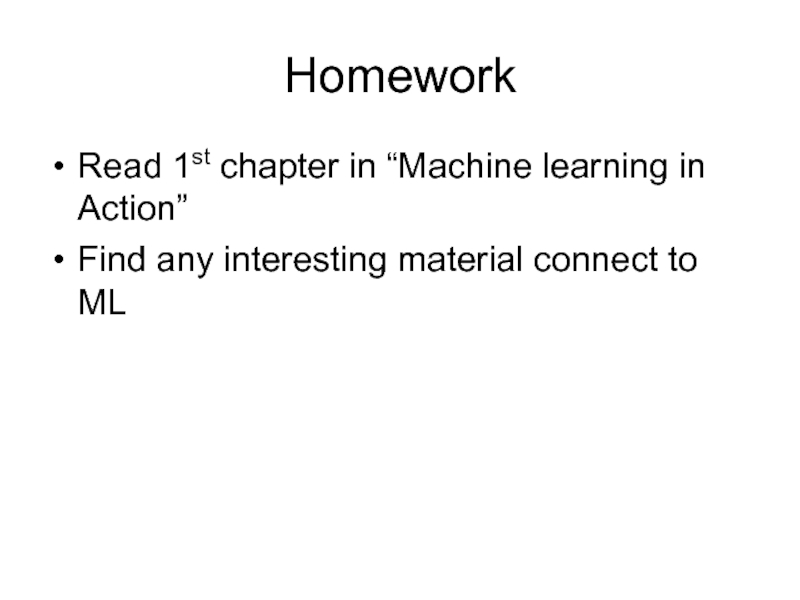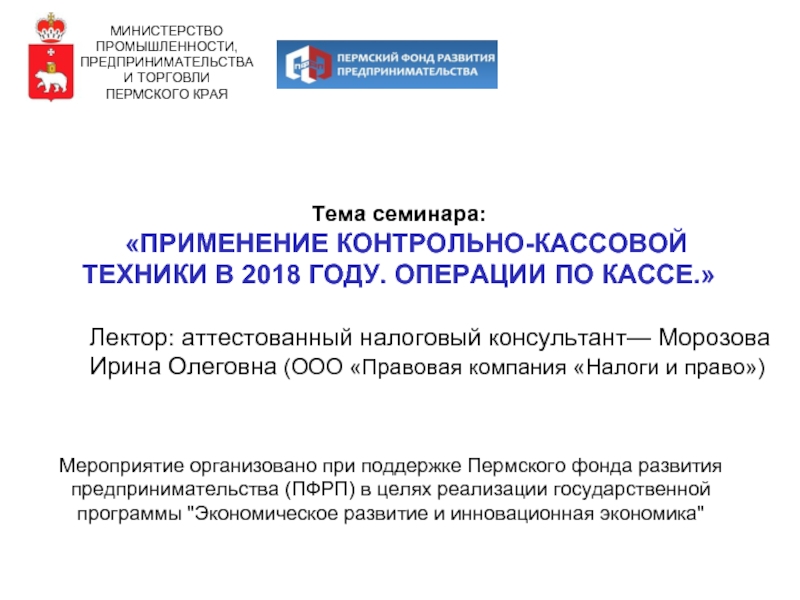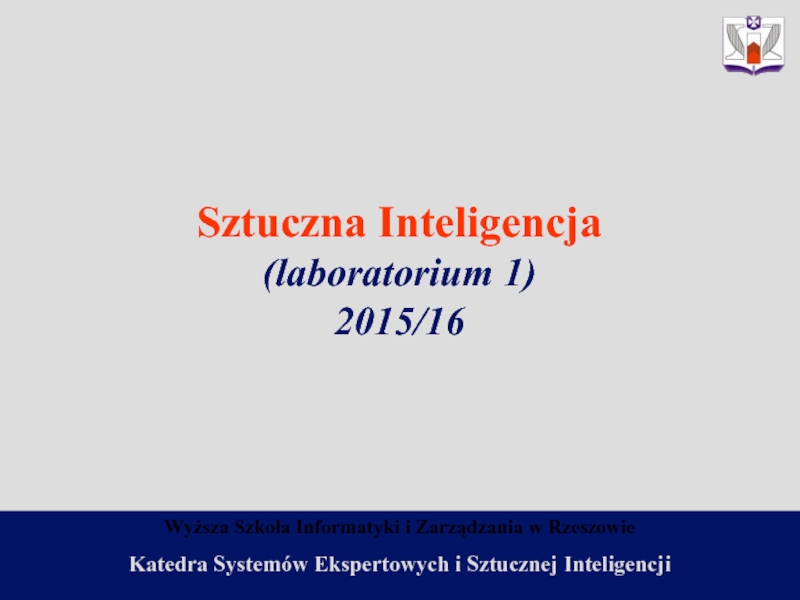- Главная
- Разное
- Дизайн
- Бизнес и предпринимательство
- Аналитика
- Образование
- Развлечения
- Красота и здоровье
- Финансы
- Государство
- Путешествия
- Спорт
- Недвижимость
- Армия
- Графика
- Культурология
- Еда и кулинария
- Лингвистика
- Английский язык
- Астрономия
- Алгебра
- Биология
- География
- Детские презентации
- Информатика
- История
- Литература
- Маркетинг
- Математика
- Медицина
- Менеджмент
- Музыка
- МХК
- Немецкий язык
- ОБЖ
- Обществознание
- Окружающий мир
- Педагогика
- Русский язык
- Технология
- Физика
- Философия
- Химия
- Шаблоны, картинки для презентаций
- Экология
- Экономика
- Юриспруденция
Introduction Machine Learning презентация
Содержание
- 1. Introduction Machine Learning
- 2. Logistics Instructor: Polichshuk Yekaterina Email: polichshuk.y.v@gmail.com Office: 262 TA: Aidos Askhatuly Email: aidos.askhatuly@gmail.com
- 3. Evaluation
- 4. Source Materials P. Harrington, Machine learning
- 5. A Few Quotes “A breakthrough in machine
- 6. So What Is Machine Learning? Automating automation
- 7. Traditional Programming
- 8. Magic? No, more like gardening
- 9. Sample Applications Web search Computational biology
- 10. ML in a Nutshell Tens of thousands
- 11. Representation Decision trees Sets of rules /
- 12. Evaluation Accuracy Precision and recall Squared error
- 13. Optimization Combinatorial optimization E.g.: Greedy search Convex
- 14. Types of Learning Supervised (inductive) learning Training
- 15. Inductive Learning Given examples of a function
- 16. What We’ll Cover Supervised learning Decision tree
- 17. Steps in developing a machine learning application
- 18. Programming languages Why Python? Python is a
- 19. Libraries: SciPy
- 20. Homework Read 1st chapter in “Machine learning
Слайд 2Logistics
Instructor: Polichshuk Yekaterina
Email: polichshuk.y.v@gmail.com
Office: 262
TA: Aidos Askhatuly
Email: aidos.askhatuly@gmail.com
Слайд 4Source Materials
P. Harrington, Machine learning in Action(Recommended)
T. Mitchell, Machine Learning,
McGraw-Hill
Online courses:
udacity.com - Introduction to machine learning
https://www.udacity.com/course/viewer#!/c-ud120/l-2254358555/e-3012748573/m-3035918544
coursera.org - Machine learning - Andrew Ng
https://www.coursera.org/learn/machine-learning/home/welcome
Слайд 5A Few Quotes
“A breakthrough in machine learning would be worth
ten Microsofts”
(Bill Gates, Chairman, Microsoft)
“Machine learning is the next Internet” (Tony Tether, Director, DARPA)
Machine learning is the hot new thing” (John Hennessy, President, Stanford)
“Web rankings today are mostly a matter of machine learning” (Prabhakar Raghavan, Dir. Research, Yahoo)
“Machine learning is going to result in a real revolution” (Greg Papadopoulos, CTO, Sun)
“Machine learning is today’s discontinuity” (Jerry Yang, CEO, Yahoo)
“Machine learning is the next Internet” (Tony Tether, Director, DARPA)
Machine learning is the hot new thing” (John Hennessy, President, Stanford)
“Web rankings today are mostly a matter of machine learning” (Prabhakar Raghavan, Dir. Research, Yahoo)
“Machine learning is going to result in a real revolution” (Greg Papadopoulos, CTO, Sun)
“Machine learning is today’s discontinuity” (Jerry Yang, CEO, Yahoo)
Слайд 6So What Is Machine Learning?
Automating automation
Getting computers to program themselves
Writing software
is the bottleneck
Let the data do the work instead!
Let the data do the work instead!
Слайд 8Magic?
No, more like gardening
Seeds = Algorithms
Nutrients = Data
Gardener = You
Plants
= Programs
Слайд 9Sample Applications
Web search
Computational biology
Finance
E-commerce
Space exploration
Robotics
Information extraction
Social networks
Debugging
[Your favorite area]
Слайд 10ML in a Nutshell
Tens of thousands of machine learning algorithms
Hundreds new
every year
Every machine learning algorithm has three components:
Representation
Evaluation
Optimization
Every machine learning algorithm has three components:
Representation
Evaluation
Optimization
Слайд 11Representation
Decision trees
Sets of rules / Logic programs
Instances
Graphical models (Bayes/Markov nets)
Neural networks
Support
vector machines
Model ensembles
Etc.
Model ensembles
Etc.
Слайд 12Evaluation
Accuracy
Precision and recall
Squared error
Likelihood
Posterior probability
Cost / Utility
Margin
Entropy
K-L divergence
Etc.
Слайд 13Optimization
Combinatorial optimization
E.g.: Greedy search
Convex optimization
E.g.: Gradient descent
Constrained optimization
E.g.: Linear programming
Слайд 14Types of Learning
Supervised (inductive) learning
Training data includes desired outputs
Unsupervised learning
Training data
does not include desired outputs
Semi-supervised learning
Training data includes a few desired outputs
Reinforcement learning
Rewards from sequence of actions
Semi-supervised learning
Training data includes a few desired outputs
Reinforcement learning
Rewards from sequence of actions
Слайд 15Inductive Learning
Given examples of a function (X, F(X))
Predict function F(X) for
new examples X
Discrete F(X): Classification
Continuous F(X): Regression
F(X) = Probability(X): Probability estimation
Discrete F(X): Classification
Continuous F(X): Regression
F(X) = Probability(X): Probability estimation
Слайд 16What We’ll Cover
Supervised learning
Decision tree induction
Rule induction
Instance-based learning
Bayesian learning
Neural networks
Support vector
machines
Model ensembles
Learning theory
Unsupervised learning
Clustering
Dimensionality reduction
Model ensembles
Learning theory
Unsupervised learning
Clustering
Dimensionality reduction
Слайд 17Steps in developing a machine learning application
Collect data.
Prepare the input data.
Analyze
the input data.
Filter garbage
Train the algorithm.
Test the algorithm.
Use it.
Filter garbage
Train the algorithm.
Test the algorithm.
Use it.
Слайд 18Programming languages
Why Python?
Python is a great language for machine learning for
a large number of reasons.
Python has clear syntax.
it makes text manipulation extremely easy.
A large number of people and organizations use Python, so there’s ample development and documentation.
Python has clear syntax.
it makes text manipulation extremely easy.
A large number of people and organizations use Python, so there’s ample development and documentation.
Слайд 20Homework
Read 1st chapter in “Machine learning in Action”
Find any interesting material
connect to ML
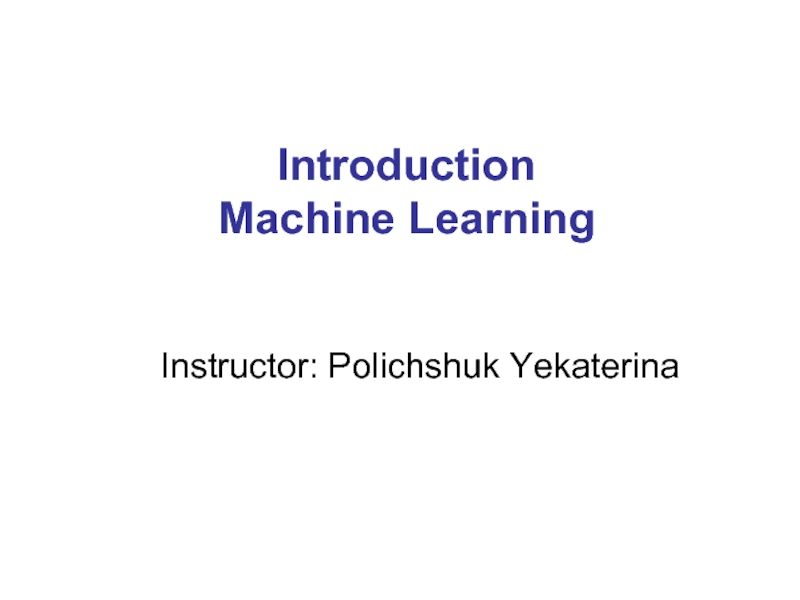

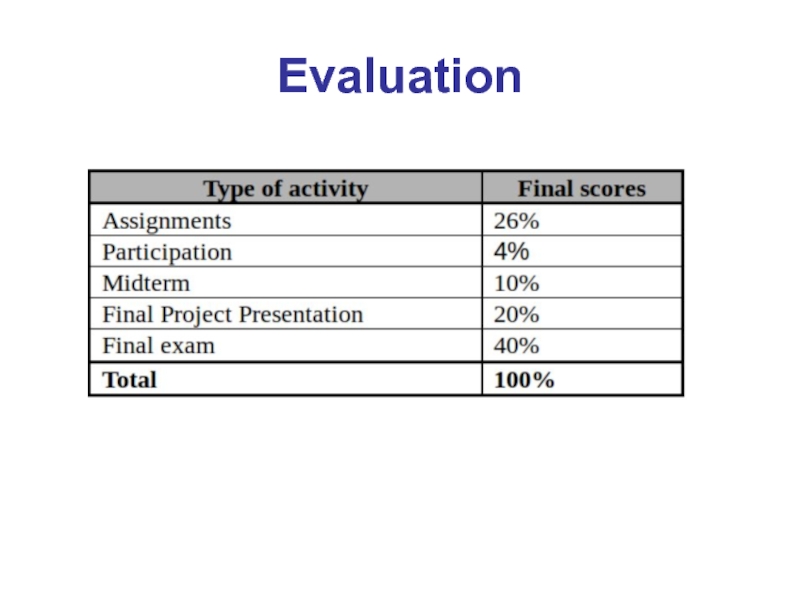




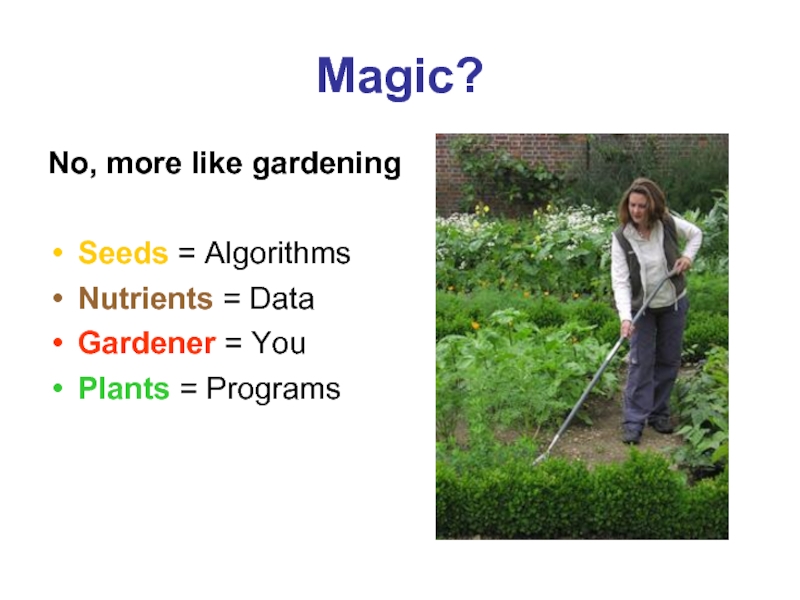
![Sample ApplicationsWeb search Computational biologyFinanceE-commerceSpace explorationRoboticsInformation extractionSocial networksDebugging[Your favorite area]](/img/tmb/3/245825/ce631e3b51d71445c4dd6c3a54ecaeb1-800x.jpg)
